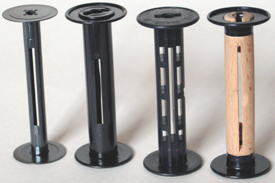Difference between revisions of "620 film"
m (CW pool for both pics) |
Steevithak (talk | contribs) m (added reference to official ISO document defining 620 film dimensions) |
||
| Line 1: | Line 1: | ||
''See the [[:Category: 620 film]] for a list of cameras using this film.'' | ''See the [[:Category: 620 film]] for a list of cameras using this film.'' | ||
| − | [[620 film]], introduced by [[Kodak]] in 1932 and discontinued in 1995,<ref name="filmhist">[http://www.nwmangum.com/Kodak/FilmHist.html History of Kodak Roll Film Numbers]</ref> is a roll film that is basically the same as [[120 film]]; it has the same width and length. The only difference is the [[spool]]; the core and the end flanges of the 620 spool are smaller than those of the 120 spool. | + | [[620 film]], introduced by [[Kodak]] in 1932 and discontinued in 1995,<ref name="filmhist">[http://www.nwmangum.com/Kodak/FilmHist.html History of Kodak Roll Film Numbers]</ref> is a roll film that is basically the same as [[120 film]]; it has the same width and length. The only difference is the [[spool]]; the core and the end flanges of the 620 spool are smaller than those of the 120 spool. The standard specifications 620 film were included in the 1982 version of the ISO standards document ISO 732, which also defines 120 and 220 roll film. However, the 1991 and later versions of ISO 732 has dropped the 620 specifications.<ref>[http://www.iso.org/iso/iso_catalogue/catalogue_ics/catalogue_detail_ics.htm?csnumber=4979 ISO 732:1982 Photography - Dimensions for 127, 120, and 620 roll film, backing paper and film spools]</ref> |
{{Flickr_image | {{Flickr_image | ||
|image_source= http://www.flickr.com/photos/bjernhage/5599915019/in/pool-camerawiki | |image_source= http://www.flickr.com/photos/bjernhage/5599915019/in/pool-camerawiki | ||
| Line 30: | Line 30: | ||
== Notes == | == Notes == | ||
| − | |||
<references/> | <references/> | ||
[[Category:Film formats]] | [[Category:Film formats]] | ||
Revision as of 16:28, 1 May 2012
See the Category: 620 film for a list of cameras using this film.
620 film, introduced by Kodak in 1932 and discontinued in 1995,[1] is a roll film that is basically the same as 120 film; it has the same width and length. The only difference is the spool; the core and the end flanges of the 620 spool are smaller than those of the 120 spool. The standard specifications 620 film were included in the 1982 version of the ISO standards document ISO 732, which also defines 120 and 220 roll film. However, the 1991 and later versions of ISO 732 has dropped the 620 specifications.[2]

|
| Typical film type reminder in Kodak camera. This one warns not to use 120 film instead of 620 film image by S. Erik Bjernhage (Image rights) |

|
| 6cm spools: 620, 120 metal, 120 plastic, 120 wood image by AWCam (Image rights) |
Using a 620 camera today: respooling or trimming 120 film
Many cameras were made to use 620 film, and such cameras normally cannot take 120 film. It's still possible to use this type of camera either by: respooling 120 film onto a 620 spool (see below), or by using standard 120 film and simply trimming the plastic spool to the diameter of a 620 spool [3].
If you wish to respool, you need two 620 spools. It is necessary to rewind the 120 film onto a 620 spool before it can be used in the camera.[4][5][6] Novices seeking to try out a vintage camera should note that this process must take place in absolute darkness, using a changing bag (marketed for such purposes as loading 135 cartridges). The film is also susceptible to damage from debris, dust, scratches or fingerprints during this procedure. 620 spools can also be bought from some suppliers, and one can occasionally be found in an old, forgotten, 620 film camera offered for sale used. A mechanically-inclined person could make their own 620 spools.
A few antique film suppliers who may still offer 620 film for sale at a premium price. This is generally rewound 120 film.
Tip: If you don't do your own processing, ask to have your spools returned, otherwise the photolab will toss them away.
Notes
- ↑ History of Kodak Roll Film Numbers
- ↑ ISO 732:1982 Photography - Dimensions for 127, 120, and 620 roll film, backing paper and film spools
- ↑ Converting 120 film to 620 film; illustrated step-by-step
- ↑ Respooling 120 film onto 620 spools for use in older cameras, an illustrated and very informative page by Glenn E Stewart
- ↑ Substituting a 120 roll film for a 620 roll film, at Mediajoy's guide to classic cameras
- ↑ Using 120 Film in 620 Cameras, by Mike Connealy